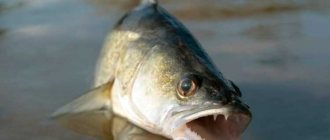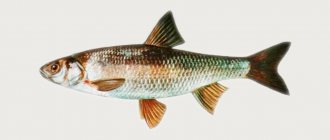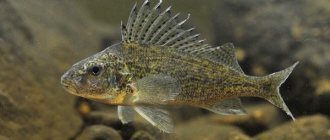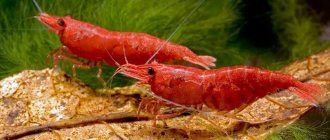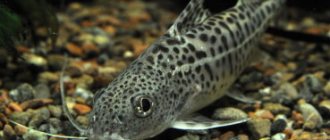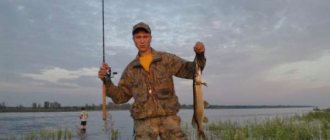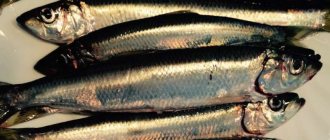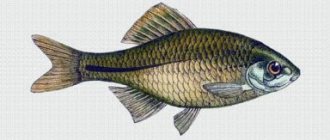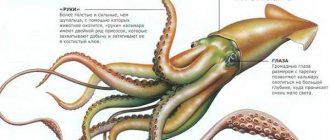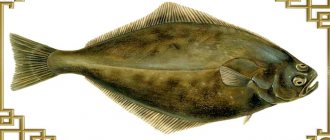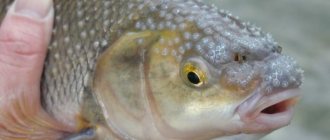- Wild animals
- >>
- Fish
Ide is a large fish, with beautiful scales that shimmer in the light and is tasty. That is why it is popular both among fishermen and for breeding - sometimes people simply admire it. They are found in most of the rivers of Europe and Siberia, are unpretentious and can live in polluted water bodies or cold climates.
Description
Ide Ide -
Leuciscus idus (Linnaeus, 1758) (synonyms, obsolete names, subspecies, forms: Cyprinus Idus, Cyprinus Orfus, Cyprinus Jeses, Idus melanotus, Squalius oxianus, Idus oxianus, Idus idus). Ide is a rather beautiful fish; it has an external resemblance to roach. Its scales have a strong golden tint, especially noticeable on the gill covers. The body is moderately elongated, higher than that of the chub. The head is small, the forehead is convex. The mouth is oblique, terminal, its apex is located noticeably below the level of the middle of the eye. The body color is silvery-yellowish. All fins are reddish in color, the ventral and anal ones are especially brightly colored. The iris of the eye is greenish-yellow. The anal fin is notched. Fin formula: D III 8 (7-9), A III 9-12. Young specimens of ide are lighter in color. Females are less brightly colored than males.
Appearance of ide
The animal has a thick body, like many inhabitants of deep waters, a small head and a convex forehead. The scales are large, silvery, the paired and anal fins are red or orange. The back is darker, the dorsal and caudal fins are gray. Representatives of both sexes look the same, only the color of the male's fins is slightly more saturated.
The fish are kept in home aquariums and ponds. There is an elite variety - orpha, or red (golden) ide, it is smaller - a maximum of 50 cm, while the common ide can grow up to 90 cm and weigh up to 8 kg. Orph's scales are orange or red. This species does not occur in nature.
Distribution and habitats
Ide is widespread in Europe and Asia. Ide is found in greater or lesser quantities in all European countries and in most of Siberia; it is not found only in Southern and Southwestern Europe, starting with eastern France. In Russia it has a very wide distribution and is found almost everywhere, with the exception of the Far North itself; in Finland it is found above the Arctic Circle; also quite common in the Northern Dvina and, according to Kessler, reaches Pechora. Ide has not been found in Transcaucasia.
It is most numerous in the rivers of the Volga basin and in central and eastern Russia, and in the south it is found in smaller numbers; in the lower reaches of large rivers it is even very rare, and in the Dniester it is not found at all. Beyond the Urals, it belongs to the most common fish, especially in the lakes of Perm and Orenburg provinces, and goes very far to the east, at least to Lake Baikal, and perhaps further. In the Turkestan region, ide is replaced by another closely related species, and it was also not found in the Caucasus.
Distribution and habitats of ide
Ide lives in rivers with moderate currents. In them, it chooses deep places with a silt-clay or cartilaginous bottom, among snags, near whirlpools, bridges, piles and other structures, as well as below riffles with a slightly slower flow. The ide also lives near the shores under trees hanging over the water, as well as near muddy streams, in river bays among rare thickets of plants, it also enters floodplain lakes (of which it prefers flowing ones). In search of food, it can go out into shallow riffles and also rise to the surface of the water. Young individuals live in small flocks, while older ones lead a predominantly solitary lifestyle. For the winter, older individuals gather in flocks, which increase in size in deep-sea areas. In winter, ides lead an active lifestyle and lie down only in the most severe frosts.
Origin of the species and description
Photo: Yaz
The oldest fossil fish, the pikaia, lived on Earth approximately 530 million years BC. She was small in size - 4-5 cm, and could swim - Pikaya did this by bending her body. Ray-finned animals, which include ide, appeared about a hundred million years later - the oldest representative of this class found is Andreolepis hedei.
Thus, ray-finned fish are one of the oldest highly organized organisms still surviving on the planet. Of course, over all the past eras they have changed a lot, and modern species appeared much later - the first teleosts appeared about 200 million years ago.
Video: Ide
At first they were small in size, their evolution proceeded slowly until the mass extinction in the Cretaceous period, when most species of large living organisms disappeared from the face of the Earth. Because of this, many niches were vacated, which the surviving ray-finned animals began to occupy: just as mammals began to dominate on land, so they do in the water. Extinction hit them too, a considerable part of the species disappeared - for example, almost all shallow-water fish became extinct.
However, according to studies of ichthyolites - microscopic particles of teeth and fish scales, if at the end of the Cretaceous period sharks dominated the seas, after the catastrophe, dominance gradually began to pass to bony fish, and the number of species and sizes of these fish began to increase.
At the same time, cyprinids arose and gradually began to spread across different continents. For example, they reached Africa approximately 20-23 million years ago. It is not precisely established when the ides arose; it probably happened only a few million years ago. The scientific description of the species was compiled by Carl Linnaeus in 1758; it was initially classified directly as a cyprinid and named Cyprinus idbarus. But then it was found that ide belongs to the genus Dace or, in Latin, Leuciscus. As a result, the modern scientific name of the species appeared - Leuciscus idus.
Age, size, spawning
The average weight of the fish is 1.5-2 kg, but there are specimens 3-4 times larger. The ide is especially beautiful in the spring in its nuptial plumage, shimmering with a metallic sheen with golden highlights.
It becomes sexually mature at 3-5 years, as a rule, this depends on the characteristics of the reservoir and its food supply. It spawns quite early, immediately after the pike, at a water temperature of 6-8°. According to popular belief, spawning begins at the time when the first leaves bloom on the birch tree.
River ide often spawns in floodplains on coastal ridges, dumps and other bottom irregularities, as well as on riffles strewn with large pebbles, stones, and plant debris. The average depth at the spawning ground is 50-80 cm.
Lake ide prefers reeds for spawning, a depth of 40-70 cm. Fertility ranges from 38 to 120 thousand eggs - this depends on the age and weight of the female. The caviar is yellowish, the size of a millet grain. In favorable weather, spawning begins in the evening and lasts until the morning. The diameter of the eggs before the start of spawning reaches 1.5-2 mm. The number of eggs laid by different females is not the same. About 128 thousand of them were found in a female 39 cm long. In the spawning herd, males are almost twice as numerous as females.
Spawning of ide.
The ide becomes sexually mature by the age of four to six years, reaching a length of twenty-five to twenty-seven centimeters. Spawning of ide begins early, as soon as the ice melts and the water warms up to a temperature of four to six degrees Celsius. To spawn, ide gather in large flocks and rush upstream. They spawn on the shallows of tributaries, small rivers, streams and even reclamation canals. The depth, as a rule, does not exceed 0.5-0.7 meters. Sometimes the fish have to travel considerable distances to do this.
The spawning process itself takes place in the morning and evening, but in warm weather it can continue all night. At the same time, the males jump out of the water, but not vertically, like a chub, but as if doing a somersault over their heads.
A female ide is capable of laying from seventy to one hundred thousand eggs. Yellowish caviar, the size of a small millet grain, the fish attaches to objects under water. The larvae emerge from it in seven to ten days.
Lifestyle
Lifestyle of ide Lives in rivers and flowing lakes.
Prefers deep backwaters, holes, whirlpools, floodplain reservoirs with clay and silted bottoms, connected to the river. A schooling fish, it can make feeding, spawning and wintering migrations over considerable distances (up to several hundred km). In early spring, it leaves its wintering grounds to the shores, rises along rivers to spawning grounds on rocky rifts. The food of ide is varied - mollusks, crustaceans, earthworms, insect larvae, small fish, and in summer plant foods become of great importance in nutrition. The ide is very careful, reacts instantly to noise, stops or moves back at the slightest danger, and often overcomes obstacles, jumping out of the water into the air. When fishing with seine, it often goes under the net in a flock and avoids capture. The sense of smell is highly developed and is attracted to odorous baits. Overwinters in deep places where there is weak flow.
Ide is resistant to sudden temperature changes and water pollution, although it prefers to stick to those places where there are key and spring sources.
Favorite habitats on moderate currents are whirlpools, holes below riffles, pits under bushes hanging over the water. It likes to stay on the border between fast currents and calm waters, where there is a lot of different food, including fry, which the ide does not disdain. It often approaches the mouths of rivers, rivers and even streams, where it rushes in pursuit of insects (as a rule, this is typical of roaches).
In rivers it feeds mainly at night and in the early morning and evening dawns, entering shallows with sand and pebble or clay, sometimes with muddy bottom.
The ide is omnivorous: it eats plankton and benthos, in the spring it prefers bloodworms, worms, mormysh and other living creatures, and in the summer it adds insects to its “diet” - grasshoppers, dragonflies and their larvae, greens, mulberry, and young shoots of reeds. But it can also become a predator, especially in the fall, when it does not gain enough fat for the upcoming winter.
The ides of lakes and reservoirs feed mainly at dawn, but often fatten during the day, especially roaches.
Features of character and lifestyle
Photo: Yazi
The ide is a smart fish, it knows how to use both bad weather and human activity: during rains and winds, as well as from passing boats, waves rise, washing worms and other living creatures out of the ground near the shore, and carrying them with them into the water. And the language is right there!
They rush to the shore along with the wave, and when it rolls back, they catch prey. Large ides prefer to feed at night, especially when twilight ends or, on the contrary, dawn is about to come - these are their favorite hours. The young spend most of the day searching for food - they are generally much more active than adults.
Yazi are cautious and try to settle in places inaccessible to the seine - for example, in holes with an uneven bottom, among snags. The larger the ide, the less often it leaves its hole - usually only after rain. But young fish, smaller ones, swim closer to the surface; they can often be seen in the grass along with roaches, and the weather has little effect on them.
Yazzies can jump out of the water to grab an insect. But when it has already entered the water, they take the prey very carefully, so that the circles spread out in small circles, as if it were a much smaller fish. When an ide hunts at depth, rising bubbles give it away.
They don’t like the sun when it starts to actively warm up, they go deeper into the water, although from time to time young fish come up to have a snack, but even then they prefer to do this near the shore, in the shade of trees or bushes - especially since there is more prey under them .
They establish this daily routine during warm periods, and spend the cold months in holes at the bottom of the reservoir. But you can catch ides even when there is ice on the river, with the exception of a couple of months - in January and February they eat practically nothing, using up their reserves, so it’s not possible to catch them.
In winter, at first the fish have enough air accumulated in the bubbles under water, but towards the end a shortage begins to be felt, due to which the ide, like other fish, float to the ice holes. Therefore, you should look for them at the confluence of small rivers and streams.
Catching ide
Catching ide You can catch ide all year round, with the exception of 1-2 months in winter, when the frost is the most severe.
Large ide bite more actively when the water warms up to 14 degrees. The most active bite is in the early morning. It is better to look for ide in pools, holes, under trees hanging over the water, on the border of currents and near river mouths. You can catch ide with any gear, from the shore and from a boat, most often with a bottom and float fishing rod, less often with a Bolognese fishing rod, a match rod, with a retrieve and a spinning rod. Fly fishing close to the surface is popular in the summer. In autumn, ide sinks closer to the bottom. In winter they fish with a regular winter fishing rod with a strong rod.
The bait may be the simplest, but fragrant. Ide likes the smell of vanilla, burnt bones, sheep's blood, birch branches, and sunflower oil. Bait can be purchased, or you can make it yourself based on grain, cake, bread with the addition of earth, clay, sand. When fishing on rivers you will need a lot of bait, on lakes - less, but the bait should have a stronger aroma.
In the spring the bait is a worm, small crawler, caddisfly, bloodworm, jig, bark beetle; in the summer it also bites on insects - dragonflies, grasshoppers and their larvae, and on greens: mulberry, reed shoots. By autumn it even feeds on fry and bites on wobblers. In winter they catch it with a spoon and a jig with a piece of fish, a jig, a worm, a maggot, a bark beetle, a leech, peas or dumplings made from semolina or flour.
The ide bites more boldly if you don’t make any noise and go into the water up to your knees. His bite is confident, but short, requiring a quick hook. When playing, it fights to the last and often goes away. When catching ide, a landing net, a yawner and an extractor can be useful.
Quite a numerous commercial species in many parts of its range. It is caught everywhere by amateur fishermen and has value as an object of sport fishing.
What does ide eat?
The diet is very varied; these representatives of the carp family are almost omnivores. Depending on the time of year, ide fish can feed on algae, various larvae, insects, small fish and even crayfish and frogs.
In the spring they are very hungry, while the water is still cloudy, they feed throughout the day and eat mainly worms and eggs of other spawners. Further, with the gradual clarification of the water and clearing of turbidity, they fatten only in the late evening, at night and early in the morning, and when the water is completely clear, they feed only at night.
At the beginning of summer, the food becomes more varied, the ide fish begins to actively eat insect larvae, dragonflies, beetles, midges, mosquitoes, maggots that fall into the river from animal carrion. With the advent of flying insects, he begins to hunt for them, his prey being cockchafers, dragonflies, grasshoppers, mayflies, moths, mosquitoes and midges falling into the river. At the same time, the ide is a predator; its diet includes small fish, and just like the chub, it is not averse to feasting on molting crayfish and even frogs in the fall.
And yet, like many fish from the carp family, in the summer in many places they prefer filamentous algae as their main food, this is a green paste of plant origin called mulberry or mulberry. It grows very quickly in standing and flowing waters on rocks, piles, submerged logs and other underwater objects. Among experienced fishermen, this algae is very often used as bait on a hook, and this method is called fishing with greens. Various fish are caught on greens, and sometimes more successfully than on other baits.
Reproduction and growth of ide
It begins to spawn at the age of 3 to 5 years. Spawning begins when the water temperature reaches 8 degrees Celsius. Spawns at depths of up to 1 meter, looking for a pebble bottom or just a bottom with uneven surfaces (river ide). Lake ide spawns in reeds. Fertility can reach 110 thousand eggs. In many regions, ide spawning coincides with high water.
The growth of ide cannot be called linear, that is, it depends on living conditions. However, this can be said about many species of fish that live in Russia. If we take average values, then in the third year of life it can reach a mass of 270 grams, in the fifth – 500-550 grams. The growth rate of ide is higher than that of some other representatives of cyprinids (for example, chub), but significantly lower than that of many other fish (pike, trout, etc.).
How to fish in winter?
Many people are interested in fishing for ide in the cold season. Here, the first thing worth knowing is that the fish most often lives alongside fish such as bream or large perch and most often lives in holes.
If the weather is good, then the fish sometimes even go aground, at the mouths of small streams and rivers.
Mostly, if you look at a photo of an ide fish, you will notice that the fish often choose places that are similar to their habitat, that is, the bottom is predominantly sandy and muddy for them, the current should not be strong.
If the fish is in close proximity to a school of bream, then it is usually located above it at a distance of about 30 cm from the bottom. You can also often see fish among a variety of flooded snags and various piles from hydraulic structures.
When does the ide fish spawn
Spawning begins in spring, from April to June. During spawning, ide changes color. becomes more beautiful. The body acquires a metallic tint, the gill covers and head become golden. In the sun, ide shimmers with either a golden or silver tint. At water temperatures up to 10 degrees. Spawns in schools in shallow waters when spring waters flood. Where there is no water spill, go into small rivers with a slight current and a sandy bottom. The fertility of eggs is up to 100,000 eggs.
After spawning, the ide fish goes to its permanent location, where it can also be caught with a donk, with a wire, with a spinning rod and fly fishing. Small fish stay in schools, large fish stay in groups of two or three fish. It does not like noise and gets scared quickly; when catching it, you need to be quiet and calm in the pond.
The ide feeds mainly on plant foods and animal foods. It could be insects. mollusks, worms, as well as underwater vegetation. It turns out that it feeds only in the evenings and at night. Actually, at this time it usually needs to be caught.
Finding a fishing spot
Winter
The ide sinks deep into the wintering pit. It rarely swims to the coastal shallows and only in good weather.
Spring
In March, ide quickly leaves large river areas for tributaries, in search of earthworms and larvae, washed away by melt water.
Summer
Small representatives often swim near steep shores at great depths. Larger individuals prefer flooded branches and widely spread aquatic vegetation.
Autumn
The movement of ide occurs in places rich in fry, these include quiet backwaters, which cover the entire surface of the reservoir with fallen leaves from nearby trees.
Up
Spawning
The ability to reproduce occurs upon reaching 2-3 years of age, with a weight of 0.25-0.30 kg. and a body length of 25 cm. After the water warms up to 6-7 degrees and the ice disappears from the river, after the flood subsides, the reproduction process occurs in early spring. However, depending on the climatic conditions of the habitat, spawning occurs from March to May. According to folk wisdom, ide is ready for reproduction after the birch buds open.
The ide gathers in large flocks that move against the current to select an area of the reservoir for breeding. From large rivers, they move to small tributaries, looking for rifts of stone 0.3-0.7 m deep for spawning with the presence of remnants of last year's food, which will serve as a substrate for eggs.
Spawning occurs early in the morning or late evening, taking no more than 2-3 days, first with large individuals, then with smaller ones. Depending on the size, the number of eggs can range from 40 to 150,000 pieces. After 7-10 days, the eggs hatch into larvae, which, thanks to an adhesive base, are held on plant leaves or stones.
Next, the fry appear and feed on their mother’s yolk sac for another 3-4 days. After the end of spawning, individuals go to the bottom, feeding abundantly, compensating for the efforts spent.
Up
How to fish correctly?
If we talk about what to catch ide with, then first of all it is worth noting the fact that you can catch fish in almost any way. You can use not only wire tackle, but also float, donkey and many other devices.
If you plan to fish from the shore, then it is best to opt for a longer rod. This is necessary primarily so that it is possible, if necessary, to cast as far as possible.
It is important to be aware that the ide fish is rightfully considered one of the most timid fish of its kind, so the use of gear that differs in power can alert it.
A bite from this fish is the sudden disappearance of the float from the field of view, as it rapidly dives into depth.
If you miss this moment, then the rod itself can sink to depth very quickly.
